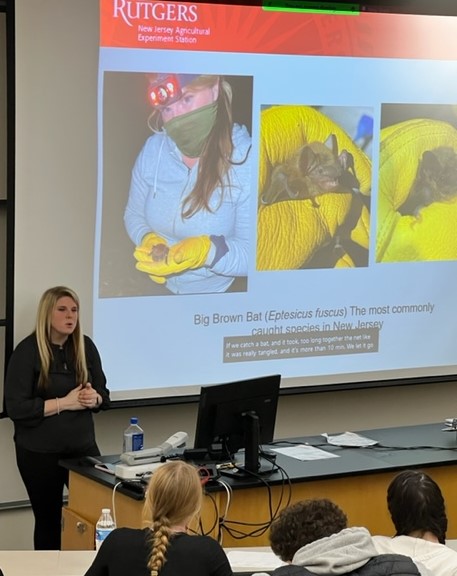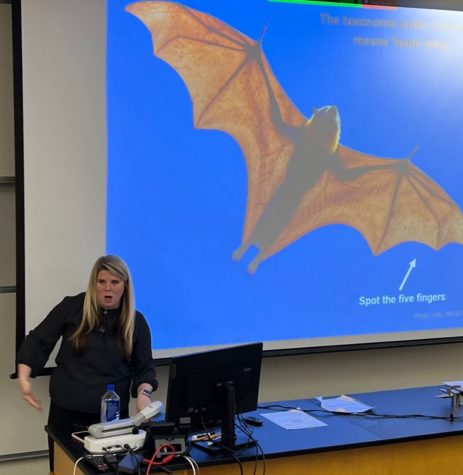Bats: The Only Mammal Capable Of True Flight

December 11, 2022
“Without bats we’d have no tequila or chocolate” said Brookdale alumna Erin M. McHale in her Dec. 8 talk “Facts About Bats of New Jersey”, part of Brookdale’s Topics in Biology series.
McHale, a PhD candidate for the department of biological sciences at Rutgers University, detailed how bats are responsible for pollinating over 95 percent of the cacao and agave plants, the sources for both tequila and chocolate.
“Bats are one of the most important animals on the planet,” McHale said. The nectar-eating bats will drink the pollen from various flowering plants, picking up pollen and spreading it from plant to plant. There are 530 species of flowering plants that would die without the pollination services of bats.”
Bats are also crucial to insect control. An active bat colony, like the Bracken Cave in Texas, can eat two tons of insects a week, McHale said.
Bats are mammals, explained McHale. They have mammary glands just like humans do. They give birth to live pups who quickly learn to fly and are actually the only mammal capable of true flight.
There are 47 species of bats in the U.S. and nine known species in New Jersey. Bat wings contain five elongated “fingers”, which help them fly. The wings are flexible, and used to hold their young, wrap around themselves to keep warm, or feed insects or even fish to themselves or their young.
How do bats stay upside down? When they find a nice spot to rest during the day, their legs clamp closed around the branch, and they can sleep soundly.
The talk focused primarily on native New Jersey bats, but McHale touched on interesting bats found worldwide. For instance, the fruit bat, found in the Philippines, is one of the biggest bats in the world, with a five-foot, five-inch wingspan. The bumblebee bat, by comparison, is smaller than the tip of your thumb.

Bats are found on every continent except Antarctica. Bats found in the northern parts of the U.S. either hibernate or migrate.
A common misconception is that bats are blind. “Bats are not blind at all,” said McHale. “They have very good vision during the day, and at nighttime they have evolved a sense of sight based on their ears. They emit a very high frequency noise – we can’t hear it – and the echo that bounces back from an object in front of them creates a visual for them and they are able to fly around trees, catch insects and see buildings.”
McHale downplayed the danger of rabies in bats and said it is extremely rare and taking common sense precautions, like not handling a bat if you find one, will prevent rabies infections.
Two bats found in New Jersey are the little brown bat and the big brown bat. These animals hibernate in caves or mines over the winter. Several other species migrate, either south to central America, Florida or even to California.
Bats mate in October, before they hibernate, and the females store the sperm until they are ready to come out of hibernation. In the spring, when she knows there is enough food and insects around, she then allows the sperm to fertilize her.
After the female has her pup(s), she will find other nursing females and form a maternity colony for warmth and protection. The pups are born blind and quickly learn to fly.
During the day, bats sleep or roost in dead trees and take off to hunt after sundown.
“Wind energy is the number one cause of death to bats,” McHale said. When migrating bats pass over these turbines, the blades create a very low-pressure area, causing the lungs of the bats to collapse and the bats to die instantly.”
McHale explained that that can be offset by lowering the motion of the blades at certain times of day when bats are passing by. You can still obtain the energy, but not cause any deaths to the bats. This hazard is now well known with plans being made to implement these changes going forward.
Another hazard bats face is called White Nose Syndrome. Approximately seven million bats have died from this deadly fungus. In some cases, the disease has wiped out 99 percent of certain bat populations.
First spread by visitors who went to an infected cave in Europe, where it is more prevalent, and upon leaving the cave, did not wash their gear or shoes. When they visited a cave in Albany, New York with infected gear, they introduced the disease, and it quickly spread throughout the Northeast and Midwest.
Research is currently underway to learn how and why some bats have recovered and why so many others are dying or have died.
It is illegal to kill a bat in New Jersey. All bats are protected under federal and state guidelines. Worldwide bats also enjoy protection because they are so valuable to agriculture.
Addressing the issue of bats in one’s home, McHale suggested simply opening a window and letting it fly out. If the animals are nesting in the attic, Rutgers has a program where they will come and help you remove and relocate the animals.
One family that had bats removed from their home soon saw an explosion of mosquitos and other insects, making it almost impossible to use their pool or rest outside. They contacted Rutgers and asked to have a bat house installed outside their home, successfully eliminating the insect problem naturally.
























